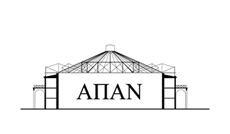Gold comb from a Scythian grave in the Ukraine, 4th c. BC: the front side
[Photos]
Title
Gold comb from a Scythian grave in the Ukraine, 4th c. BC: the front side
Description
Gold comb from a Scythian grave in the Melitopol' region (between the Sea of Azov and the Dnieper). H. 12.6 cm., w. 10.2 cm., wt 294 g. First half of the 4th c. BC. This exquisite example of miniature sculpting in gold was fashioned in an Euxine workshop, probably at Pantikapaion, capital of the Bosporian realm.
The comb has the form of the façade of an ancient Greek temple, with columns, metopes and triglyphs, and a pedimental finial. The composition is sculpted in the round and divided into three registers.
A: The comb's nineteen teeth have been fashioned with strict precision, emphasizing its vertical axis.
B: The narrow band with five lions forms the baseline for the martial scene, discreetly but clearly separating it from the actual comb.
C: The third register is developed within a free triangular or pedimental space. The equestrian warrior and the horse's head fill the apex of the triangle and define its two sides. The two Scythian infantrymen, attacking one another head on, in a perfectly balanced composition, close the two sides of the triangle, each with his lunging body and outstretched leg. The combatant on the left is propelled by his left leg, and that on the right by his right, as both rush towards the centre where the dramatic and vigorous scene reaches its climax. The wounded horse links the two adversaries. Its head is on the central vertical axis of the composition, its body underscores the horizontality of the intermediate register with the lions, and its two front legs, close to its body, accentuate the two reared forelegs of the horse being attacked.
Hermitage Museum, St Petersburg
The comb has the form of the façade of an ancient Greek temple, with columns, metopes and triglyphs, and a pedimental finial. The composition is sculpted in the round and divided into three registers.
A: The comb's nineteen teeth have been fashioned with strict precision, emphasizing its vertical axis.
B: The narrow band with five lions forms the baseline for the martial scene, discreetly but clearly separating it from the actual comb.
C: The third register is developed within a free triangular or pedimental space. The equestrian warrior and the horse's head fill the apex of the triangle and define its two sides. The two Scythian infantrymen, attacking one another head on, in a perfectly balanced composition, close the two sides of the triangle, each with his lunging body and outstretched leg. The combatant on the left is propelled by his left leg, and that on the right by his right, as both rush towards the centre where the dramatic and vigorous scene reaches its climax. The wounded horse links the two adversaries. Its head is on the central vertical axis of the composition, its body underscores the horizontality of the intermediate register with the lions, and its two front legs, close to its body, accentuate the two reared forelegs of the horse being attacked.
Hermitage Museum, St Petersburg
Original
Yes
Source
APAN Archive
© APAN
Yes
Color
Yes
Key words
Ancient Greek art.
Classical period.
Gold.
Hermitage, museum.
Horse, horses.
Horse-rider / Rider, riders.
Scythians.
Sea of Azov.
Silversmithery.
Ukraine.
Weapons, arms.

